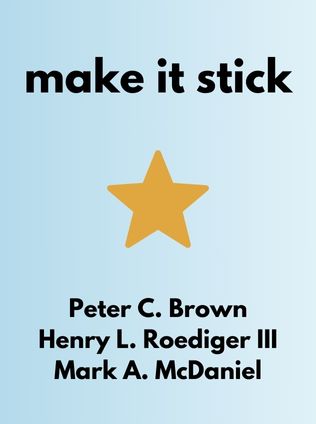
Make It Stick
The Science of Successful Learning
By Peter C. Brown, Henry L. Roediger III, Mark A. McDaniel
Published 04/2014
About the Author
Peter C. Brown is a well-known author and educator who has dedicated his career to exploring the intricacies of learning and memory. His collaboration with cognitive scientists Henry L. Roediger III and Mark A. McDaniel on "Make It Stick: The Science of Successful Learning" represents a synthesis of years of research in cognitive psychology and educational practices. Brown’s engaging writing style, combined with Roediger and McDaniel’s research-driven insights, makes complex scientific ideas accessible to a broad audience. The authors aim to challenge traditional educational methods and offer new, evidence-based approaches that enhance learning and retention.
Henry L. Roediger III and Mark A. McDaniel are prominent cognitive psychologists whose research has significantly impacted our understanding of memory and learning processes. Their work spans several decades and includes groundbreaking studies on how people learn and remember. Together with Brown, they have created a book that not only dispels common myths about learning but also provides practical strategies that can be applied in everyday life, whether you are a student, teacher, or lifelong learner.
Main Idea
"Make It Stick" is a groundbreaking book that seeks to transform the way we think about learning. The authors argue that many of the most commonly used learning strategies are ineffective and that the true art of learning lies in employing techniques that may initially seem counterintuitive. These include retrieval practice, spacing, and interleaving, which are proven to enhance understanding and retention far more effectively than traditional methods like rereading or cramming.
The book emphasizes that learning is not just about the accumulation of knowledge but about developing a deep understanding that can be applied in various contexts. This approach requires effortful learning, where learners actively engage with the material, test themselves frequently, and embrace challenges as opportunities to grow. The authors stress that true learning is a lifelong process that involves continuous reflection and adaptation.
Table of Contents
- Introduction
- The Science of Learning
- Retrieval Practice
- Spacing and Interleaving
- Effortful Learning
- Misconceptions About Learning
- Applying the Principles
- Conclusion
Introduction
The introduction to "Make It Stick" sets the stage by challenging the reader's assumptions about learning. The authors point out that many people, including students, educators, and professionals, hold onto ineffective learning methods, such as rereading texts, highlighting passages, and cramming before exams. These methods, while commonly used, are not only inefficient but also contribute to shallow learning that is easily forgotten.
The authors argue that true learning involves more than just memorizing facts. It requires a deeper understanding of concepts and the ability to apply knowledge in different situations. This process, known as meaningful learning, is essential for developing expertise and mastery in any field. The introduction highlights the need for a paradigm shift in how we approach learning, moving away from passive techniques and towards active, effortful learning strategies.
The Science of Learning
In this chapter, the authors delve into the cognitive science behind learning and memory. They explain that learning is not a passive process but an active one that requires the learner to engage deeply with the material. One of the key concepts introduced is structure building, which involves identifying the underlying principles or rules that govern a particular subject and connecting these principles with prior knowledge.
For example, when learning about the concept of gravity in physics, a student might first understand the basic principle that objects are attracted to each other. This foundational knowledge can then be expanded to include the laws of motion, the effects of gravity on different celestial bodies, and how gravity influences the structure of the universe. By building on these basic principles, the student develops a deeper understanding of the subject.
The authors emphasize the importance of mental models, which are cognitive frameworks that help us organize and interpret information. Mental models allow us to integrate new knowledge with existing knowledge, making it easier to apply what we've learned in new situations. For instance, a chess player might develop a mental model of different strategies and tactics, allowing them to anticipate their opponent's moves and plan their own moves accordingly.
The process of creating and refining mental models is critical for achieving mastery in any field. The more mental models a learner develops, the better equipped they are to navigate complex situations and solve problems. This chapter also touches on the importance of metacognition, or the ability to think about one's own thinking processes. Metacognition allows learners to evaluate their understanding, identify gaps in their knowledge, and adjust their learning strategies accordingly.
Sign up for FREE and get access to 1,400+ books summaries.
You May Also Like
The Subtle Art of Not Giving a F*ck
A Counterintuitive Approach to Living a Good Life
By Mark MansonRich Dad Poor Dad
What the Rich Teach Their Kids About Money - That the Poor and Middle Class Do Not!
By Robert T. KiyosakiHow To Win Friends and Influence People
The All-Time Classic Manual Of People Skills
By Dale CarnegieFreakonomics
A Rogue Economist Explores the Hidden Side of Everything
By Steven D. Levitt and Stephen J. DubnerI Am Malala
The Story of the Girl Who Stood Up for Education and Was Shot by the Taliban
By Malala Yousafzai



















